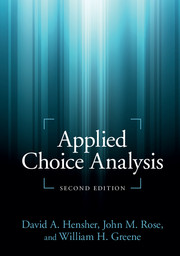Book contents
- Frontmatter
- Contents
- List of Figures
- List of Tables
- Preface
- Part I Getting started
- Part II Software and data
- Part III The suite of choice models
- 11 Getting started modeling: the workhorse – multinomial logit
- 12 Handling unlabeled discrete choice data
- 13 Getting more from your model
- 14 Nested logit estimation
- 15 Mixed logit estimation
- 16 Latent class models
- 17 Binary choice models
- 18 Ordered choices
- 19 Combining sources of data
- Part IV Advanced topics
- Select glossary
- References
- Index
17 - Binary choice models
from Part III - The suite of choice models
Published online by Cambridge University Press: 05 June 2015
- Frontmatter
- Contents
- List of Figures
- List of Tables
- Preface
- Part I Getting started
- Part II Software and data
- Part III The suite of choice models
- 11 Getting started modeling: the workhorse – multinomial logit
- 12 Handling unlabeled discrete choice data
- 13 Getting more from your model
- 14 Nested logit estimation
- 15 Mixed logit estimation
- 16 Latent class models
- 17 Binary choice models
- 18 Ordered choices
- 19 Combining sources of data
- Part IV Advanced topics
- Select glossary
- References
- Index
Summary
Introduction
This chapter introduces one of the fundamental pillars of choice modeling, the canonical model for choice between two alternatives. At the most basic level, the model describes the activity between taking an action and not taking that action – i.e., whether or not to use public transport to commute to work, whether or not to purchase a car, whether or not to accept an offered plan for delivery of a utility service such as electricity, and so on. A straightforward extension that provides a bridge to most of the choice models discussed elsewhere in this book describes the choice between two specific alternatives – i.e., whether to use public transport or drive one’s own car to commute to work, whether to choose a new technology (e.g., electric) vehicle or a conventionally powered vehicle, or whether to choose a utility plan that includes time varying rates or one that does not (but includes other desirable features).
We begin with the essential binary choice between an outcome and “not.” Issues of specification, estimation, and inference are detailed. We will then extend the model in several directions, concluding with multiple equation situations and analysis of panel data. Some of the econometric presentation is an interpretation of material already covered in earlier chapters; however, we believe it is useful to include the material here as a way of relating the essential elements to the popular binary choice model.
Information
- Type
- Chapter
- Information
- Applied Choice Analysis , pp. 742 - 803Publisher: Cambridge University PressPrint publication year: 2015
